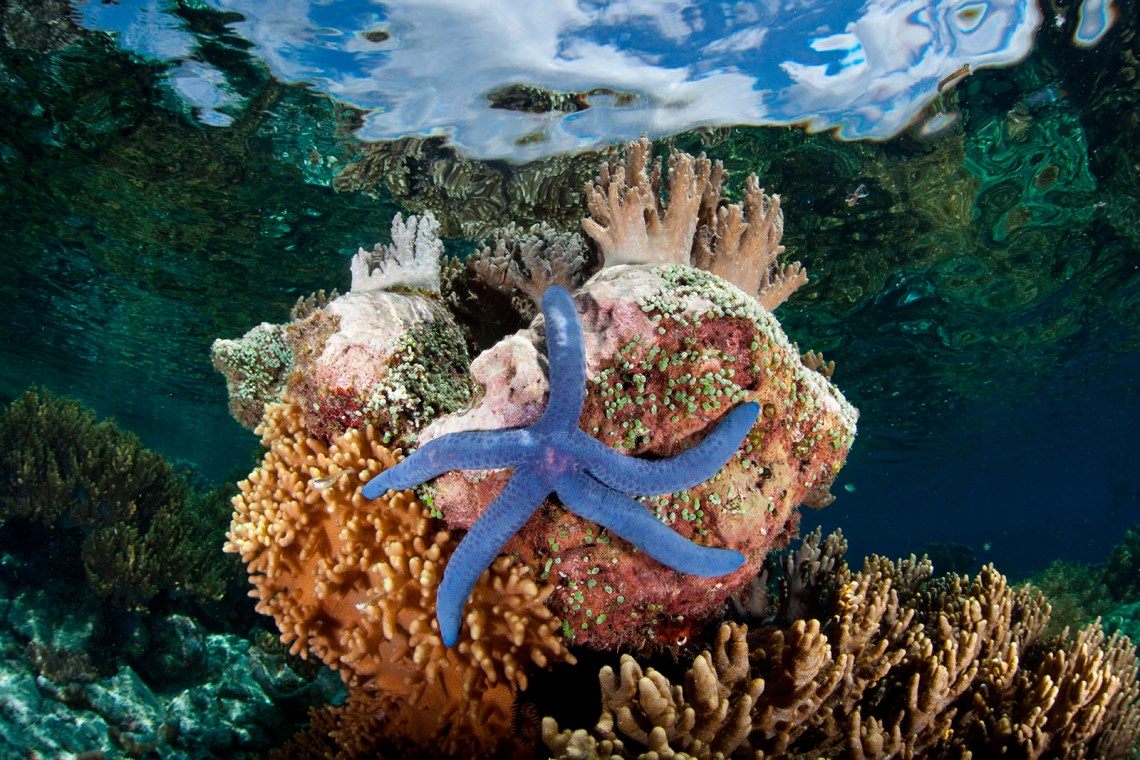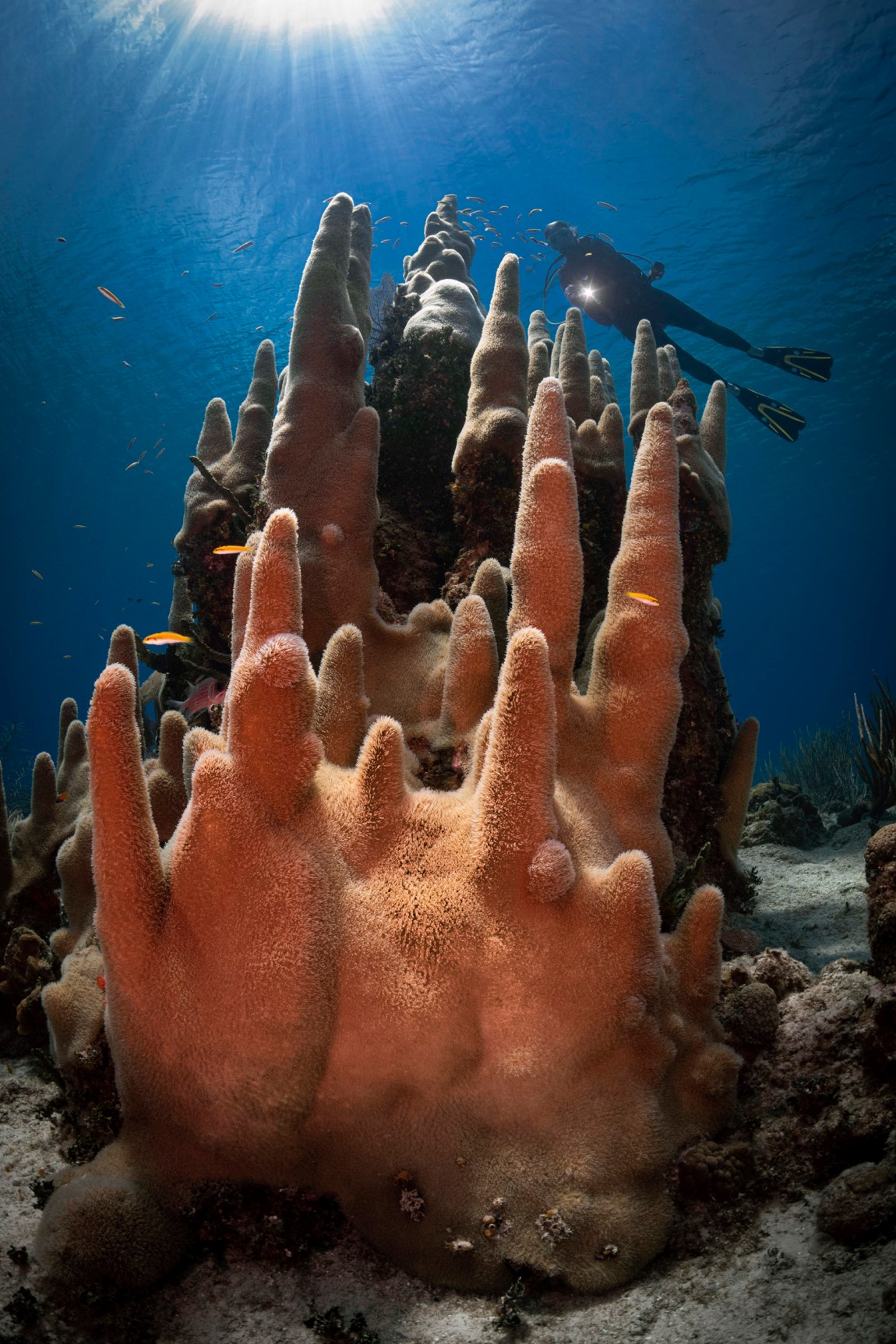Snorkeling or diving over a coral reef, with its exceptionally vivid colors and proliferation of life in utterly unfamiliar forms, is about as close as most people get to visiting an alien world. The temptation is to try to take in the reef as a whole, but the true wonder lies in observing it up close. The closer you look, the more layers of complexity and living brilliance are revealed: follow a minuscule fish, its front half electric blue, its rear brilliant orange, as it scoots along and you can find yourself in the purple maw of a giant clam so expansive as to appear at first glance to be a mountain range. The most exquisite variety of tubes, tendrils, starbursts, and spines make up something so large that it can be seen from space.
The genesis of the world’s coral reefs occurred 54 million years ago, in a long-lost sea called the Tethys, in what is today Southern Europe. Back then the world was recovering from devastating climate heating caused by carbon dioxide and methane that escaped from Earth’s crust, and that both warmed and acidified the oceans, precipitating an extinction event and reorganizing the circulation of ocean currents. As the greenhouse gases were gradually absorbed into rocks over the course of hundreds of thousands of years, the oceans cooled and regained their alkalinity, creating conditions favorable to reef-building corals. The biodiversity characteristic of the modern coral reef arose so quickly that it appears to have been almost fully formed, like Dionysus springing from Zeus’s thigh. And through all the subsequent ice ages and drifting of continents, the essential composition of coral reefs remained unchanged.
Charles Sheppard’s Coral Reefs: A Natural History not only explains what corals are and how they live, but reveals through exquisite photography the glories of the reef at all scales. Flipping through its pages I was filled with both wonder and sadness, for few reefs today possess such untrammeled beauty. Many of those I’ve dived on of late have begun to sicken and die. It’s a worldwide trend that is accelerating so quickly that we may live to see the end of coral reefs. A scientific study published this year indicates that once global heating reaches 1.5 degrees Celsius, almost no corals will avoid severe bleaching, which leaves them vulnerable to disease and starvation.1 If current trends continue, we’ll hit that temperature mark in the early 2030s. Just 0.2 percent of reefs will escape bleaching—an outcome that researchers say will be catastrophic.
The cause of this disaster, and what can be done about it, is the focus of Juli Berwald’s splendid new book, Life on the Rocks. Berwald’s great strength lies in revealing a fast-moving, complex global catastrophe through easily understood case studies, and few are as troubling as that provided by Australia’s Great Barrier Reef. The world’s largest reef system stretches 1,400 miles north to south and covers an area around the size of Italy. In the late 1920s the Royal Geographical Society of Australasia organized an expedition to study it in depth for the first time, dispatching a young oyster researcher named Maurice Yonge and his doctor wife, Mattie, to the Low Isles, in the northern section of the reef. In today’s interconnected, environmentally damaged world, it’s hard to comprehend the adventure the young couple must have had, living for months at a time with twenty other researchers on a tropical island in a maritime Garden of Eden.
Lacking diving equipment, the team worked at low tide, documenting the condition and diversity of the coral. In February 1929 Maurice was astonished to find that the seawater in the pools left by the receding tide was “literally hot to the touch,” and on a subsequent low tide he noticed that large patches of the stony, branching coral that dominated the healthy reef had turned white—the first recorded instance of coral bleaching as a result of elevated sea temperature. But by the time of the next extreme low tide, in April, the corals had returned to their usual color. We now know that such bleaching and recovery is a normal response to stress by corals. Bleaching becomes deadly only when high temperatures persist.
In 2019 researchers returned to the location in the Low Isles studied by Yonge and his team, repeating the observations taken ninety years earlier. They found that the water temperature had risen from an average of 26.6 degrees Celsius to 27.7 degrees Celsius, the water was far more acidic, and the level of the sea had risen by more than eight inches. But what shocked them most of all was the state of the coral reef itself. The branching stony corals that had dominated in 1929, and that Yonge had seen bleach and recover, had been almost entirely replaced with soft corals. The massive stony corals, such as boulder corals, had done a little better: some had survived, but they were on average 30 percent smaller than those measured by Yonge. Soft corals don’t provide the caves and smaller refuges for marine life that branching stony corals do. Without shelter, myriad species of crabs, shellfish, and other life-forms had vanished. The riot of life that Yonge observed in the 1920s had been replaced by a pale, ghostly, and ecologically devastated simulacrum.
Advertisement
The great majority of the damage inflicted on the world’s coral reefs has occurred within the lifetimes of researchers who are active in the field. The most visible and widespread damage is bleaching caused by global heating, and Berwald explains in detail how this occurs. Coral reefs come about, she says, because of a “badass merger” between the coral animal (a polyp like a miniature sea anemone) and single-celled algae. Both partners receive benefits—the algae get protection and the CO2 they need to grow, while the coral polyp receives food in the form of sugars produced by the algae during photosynthesis. So powerful is the partnership that it can increase the production of food a hundredfold.
Bleaching is visible evidence that the relationship has broken down. The corals are themselves colorless—it’s the algae that give color to the reef. Each coral has its own algal partner, and some kinds of algae don’t produce as much food when temperatures rise. Berwald writes that it’s not clear whether the coral animal actively ejects the algae or the algae leave of their own accord, but once the relationship ends, the coral loses most of its food supply. The algae won’t return until the water temperature falls, and if the algae are away too long, the coral dies of starvation.
Coral bleaching is the single greatest threat faced by coral reefs. Yet bleaching leading to widespread coral death was not observed until 1980, and the first such event in the Great Barrier Reef, according to Berwald, was observed only in 1998, by which time bleaching events had been seen around the world. By 2015 bleaching had taken on terrifying proportions, afflicting reefs from Guam to Hawaii and from Fiji to French Polynesia. Richard Vevers, a researcher who dived on the reefs as they died, recalls, “I can’t even tell you how bad I smelt after the dive—the smell of millions of rotting animals.”
Despite the scale of the threat, not all researchers agree that bleaching will cause the extinction of coral reefs. Misha Matz uses algorithms to assess the threat of bleaching. “I cannot make [reefs] go extinct,” he tells Berwald when she visits his lab. “I’m sorry, it’s impossible.” Matz’s optimistic view is clearly in the minority, but as Berwald tells it, the biological complexity of coral reefs is so great that it’s hard to draw firm conclusions about anything. Yet observations indicate that there are limits beyond which coral reefs experience catastrophic decline. Even if Matz is right and reefs don’t go extinct, is it acceptable if only 0.2 percent of corals escape bleaching after 2030, as the 2022 study predicted?
Life on the Rocks is far more than a paean to coral. Interwoven with Berwald’s research is an account of the mental health of her daughter, Isy. We meet Isy when she’s in eighth grade. She always had lots of friends, but halfway through the year she abruptly ditches them all, becomes reclusive, and begins washing her hands compulsively and receiving failing grades. She is, we later learn, falling victim to obsessive-compulsive disorder. The creeping horror any parent feels at such a transformation in a child is palpable in Berwald’s response. At first she feels helpless and blindsided, but then she starts to investigate possible causes, such as bacterial or viral infections that may be linked to OCD. Despite some short-term remissions, it is not until Isy tries long-term therapy at a residential mental health program that real progress is made. But success is always qualified. Berwald puts the experience to good purpose, astutely weaving together the story about uncertainty that surrounds both OCD and reef science, as well as the slow and uncertain nature of recovery. Other tangents are less fruitful—for example, Berwald discusses Black Lives Matter at length, on the basis that “the work of academics…is steeped in and has a very old legacy of racism” and because of the colonial histories of many countries where coral reefs can be found. This is indisputably true, but a book about everything risks being a book about nothing.
Bleaching is not the only threat facing coral reefs. In Florida and the Caribbean, a disease known as stony coral tissue loss is devastating reefs. It kills swiftly and progresses through a community in the same pattern, first killing the maze corals, then the elliptical and star corals, then the brain coral, leaving behind a nightmare landscape. It was first seen near Miami, but at the time of Berwald’s writing it had reached beyond the Dominican Republic and as far as St. Maarten, where it had killed 70 percent of corals near a marine protected area. No cause has been identified.
Advertisement
Then there are poisons and bombs. In the islands of the southwest Pacific, fishermen craft homemade bombs from fertilizer and kerosene. By 2009, 70 percent of fish being sold in Philippine fish markets bore the telltale scars of illegal blast fishing. The practice is dangerous to fishermen as well as to reefs, but it continues because it is rewarding in the short term—even when fines are taken into account, a blast fisherman can earn ten to fifteen times as much as someone using other methods. Yet thirty years after the blast, an affected reef remains rubble, since the loose rock created by the explosion prevents new coral from taking hold.
What the bombs spare often sops up cyanide, which local fishers squirt into the nooks and crannies of reefs to stun small fish and sell them in the aquarium trade. “In 2016,” Berwald writes, “more than half the fish in aquarium shops tested positive for cyanide poisoning.” In light of this, you might expect her to be critical of aquarists. But instead she finds a bright side to their hobby, visiting a commercial coral farm off Bali and meeting hobbyists who breed corals; Berwald argues that their expertise might help scientists who hope to breed heat-hardy specimens.
One threat to corals that has perhaps been overhyped concerns the effect of sunscreen containing oxybenzone. The issue was studied by Craig Downs, whose laboratory research demonstrated that oxybenzone affects coral at various life stages. When this became widely known, it led to calls to end the use of the chemical. Yet studies of the impact of oxybenzone on coral reefs have yielded only equivocal results. Perhaps, Berwald opines, the popularity of the move to ban oxybenzone owes as much to a desire to do something in the face of the threats to coral reefs, even if that something is of marginal utility.
The most surprising aspect of Life on the Rocks is surely the many efforts being made to save coral reefs. In the waters off Sulawesi, Indonesia, an initiative funded by Frank Mars (a board member of Mars Inc.) is restoring coral reefs that were devastated by blasting. The technique involves planting fragments of coral onto star-shaped structures made of rebar (steel reinforcing bars), then attaching them to what’s left of the reef. Even after just two years, the results are spectacular, the rebar being so overgrown with coral that it had disappeared from view. Berwald’s reverie at the sight of one reviving reef is, sadly, interrupted by an abrupt and loud explosion. Somewhere within earshot of the restoration, another reef was being reduced to rubble.
One heartening initiative Berwald explores is a debt-swap system pioneered by the Nature Conservancy, a complex financial arrangement whereby countries indebted to the US have some of their obligation discounted in exchange for allowing an environmental organization to help manage the nation’s biodiversity. The program has had a positive effect in the Seychelles, where enormous marine protected areas have been established, creating local employment through tourism and management. But it’s not clear whether these protected areas can survive bleaching in a world where temperatures have increased by 1.5 degrees Celsius.
Line Bay, a geneticist working with the Great Barrier Reef Marine Park Authority, is attempting to breed hybrid corals that she hopes can cope with hotter temperatures. Her vision involves developing coral husbandry programs, testing the hybrid corals for hardiness, growing vast numbers in nurseries, then planting them en masse, monitoring them, and keeping stores of frozen eggs and sperm in case of failure. Some progress has been made, but the problem with this approach—as indeed with almost all reef restoration projects—is that of scale.
There are around 108,000 square miles of coral reef in the world, around half of which are already damaged or dead. Frank Mars’s restoration project in Indonesia spends only one to two dollars on every coral it plants, but to restore just 10 percent of the world’s reefs using his method would cost $4 trillion to $8 trillion. That’s hundreds of times more than the EPA’s entire annual budget. And, of course, to make rebar using conventional methods releases enormous volumes of CO2.
There is one audacious approach, however, that may be able to make a large-scale difference. After considering a number of approaches to protecting the Great Barrier Reef from heat, including pumping cool water from the deep ocean onto the reef and spreading a chalk film on the water’s surface to act as a sunshade, the Australian scientist Daniel Harrison decided that the only feasible method was to brighten the clouds that protect the reef from the sun. Bright clouds reflect more light, thus preventing light from being transformed into heat at the Earth’s surface. Cloud brightening, Harrison hypothesized, could be achieved by spraying tiny droplets of seawater into the air, provided they could drift up until they reached the surface of clouds.
To test the idea, the Australian federal government funded the conversion of an old ferry into a platform for spraying droplets of seawater, and by March 2021 the experiment was underway. While the effort was too small to affect the brightness of any clouds, early results did demonstrate that droplets formed at the sea surface can ascend to the cloud layer. Whether a greater number of droplets would indeed brighten clouds, and what effect that would have on the Great Barrier Reef, remains unknown. Ominously, however, the reef is increasingly falling victim to marine heat waves tens of yards deep, which roll in from the Pacific Ocean and hover against the reef front. No amount of local cloud-brightening effects is likely to prevent these heat waves, which have their origins many thousands of miles away.
Can coral reefs survive long enough for our children or grandchildren to wonder at them? We began to take the threat to reefs seriously only in the very late stages of their decline, and huge commitments are required to scale up potential solutions. Berwald finds hope in two major philanthropies, the Paul G. Allen Family Foundation and the Prince Albert II of Monaco Foundation,2 which together established the Global Fund for Coral Reefs. In launching the $500 million investment, Prince Albert II said, “In order to have a chance to save corals, we would need to take action within the next decade.” And he was in no doubt about the kind of action required: “It is by reducing the damage of a carbon economy that we will be able to protect corals sustainably.” Sadly, it really is as simple and as difficult as that.





